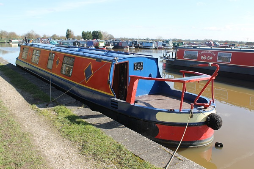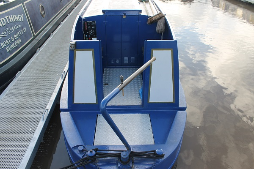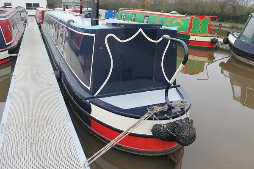If you’re new to boating we’ve put together a list of boating basics that you might find useful. There’s information here from narrowboat basics, what’s on board to running costs.
What’s the difference between Narrowboats, Widebeams and Barges?
Narrowboats are usually 6 feet 10 inches wide. Generally they are all made entirely of steel, although some older boats have wooden and sometimes even glass reinforced plastic (GRP) cabins. Widebeams are wider than narrowboats, generally between 10 and 12ft wide, and dutch barges are larger still. Our canals are designed around narrowboats; with this type of vessel you can travel the whole waterways system, whereas you can’t do that with a widebeam because many of the canals are too narrow.
Does the size of your boat matter?
This depends on your needs, the number of people who will be aboard and how much time you will be spending on the boat. Generally speaking, a 30-40 foot boat is ample as a holiday boat, whilst a 50 plus foot boat is ideal for extended cruising or living aboard. There is a myth that boats must be no longer than 57 feet long, because some locks have a maximum length of 60 feet. (for example the Calder and Hebble restricts boats to 60 feet and the Leeds and Liverpool Canal has a limit of 62 feet.) But even if you buy a longer boat, you will be able take in most of the canal system. If you’re not sure if a certain boat will suit you, just tell us where you want to take the boat and we can give you advice.
Waterways World Magazine also sells an annual magazine where there is usually a free map of the inland waterways, showing which canals are wider than others. This is a particularly useful tool for widebeam boaters to see where they can and can’t go.
Wondering which narrowboat stern to choose?
There are three main types of stern on narrowboats, traditional, cruiser and semi-traditional.
Traditional Stern- This is the smallest stern area offering the least external space.
Cruiser Stern – Offers a large external space and is ideal for recreational cruising.
Semi-traditional Stern – Is a compromise between a traditional and cruiser, with the looks of a traditional stern, but the space of a cruiser
What’s On Board
A quick guide to some of the services and utilities you will find on a narrowboat. Hopefully this will help to guide your purchase based on what’s most important to you personally.
Electricity
All boats rely on a 12-volt supply from two battery banks. One bank starts the engine (like a car battery); the other powers domestic items such as at TV, lighting and your water pump.
For 240-volt items, you need to connect from a shore or land line, plugging into an electricity supply where available.
Or you can use an inverter, which converts battery power to 240v.
The alternative is to buy 12-volt compatible fridges, TVs and so on; these are very efficient for boats but are also more expensive to buy.
Running Water
There is a water tank that you fill with a hosepipe, this feeds an internal system which gives you running water. The pressure is obtained by a water pump.
On board tanks
You can heat domestic water from a holding tank or use the water for a pumpout toilet. Tanks are either made from steel, stainless steel or plastic.
Hot water
You can heat domestic water by an instant gas water heater (such as a Paloma or diesel heater).
Or you can use a calorifier; this uses excess hot water from the engine cooling system or central heating boiler.
Diesel fired heating such as Webasto, Mikuni and Eberspacher also provides hot water.
Toilets
Pumpout – These toilets flush, emptying into a holding tank and you have to pay pump-out costs, which differ from marina to marina
Cassette – These toilets empty into a cartridge that you lift out and empty at any Canal and River Trust elsan point.
Engine – three main types
Air cooled- Like a car engine, these rely on a flow of air to keep them cool.
Keel cooled – The engine is cooled by the flow of water through a tank on the stern of the boat; most modern engines use this system.
Raw water cooled – Takes pumped water from the canal which is pushed around the engine and uses a heat exchange to cool it down.
Heating - three main types
Heating type is down to personal choice. Many people like the dry heat of a solid fuel stove, but it takes time to prepare the fire; whereas gas and diesel provide almost instant heat.
Solid fuel stove – Such as a Morso Squirrel.
Gas central heating – Such as Alde.
Diesel fired heating – Such as Webasto, Mikuni and Eberspacher.
Running Costs of a Narrow Boat
Insurance
There are two types of insurance
1) Fully comprehensive
2) Third Party
We recommend that you use a specialist marine insurance company as they will understand your specific needs. For older boats that are over 20 years you may need to get the boat surveyed to get insurance. Licences
Most waters are Canal and River Trust (CRT) controlled and you will need a current license to cruise them. Take a look at the CRT’s website for the current license costs. http://canalrivertrust.org.uk/boating/licensing/application-forms-fees-and-useful-downloads
Some rivers are controlled by the environment agency. If you’re going to be cruising on a river then you’re best to contact them to check if you’ll be using their waterways.
https://www.gov.uk/browse/environment-countryside/boats-waterways
Moorings
These are probably the most significant costs. Mooring costs vary from location to location and facilities. Each marina sets its own price and has its own rules and regulations. Sometimes prices are charged per foot, whereas other marinas charge per pier.
The CRT have linear moorings along the canal. Take a look at their website for more information. https://www.crtmoorings.com/
Fuel
Heating costs vary depending on usage. Webasto quotes a figure of 0.25 to 0.5 litres of fuel per hour, depending on the load.
The average gas system consumes in the region of 465g/H per hour, which means a 13Kg gas bottle will last for approximately 28 hours of continuous burn time.
Narrowboat fuel tanks are typically 200 litres.
Engine consumption is around 1 litre per hour of cruising.
Maintenance
The costs of maintaining your boat can vary depending on usage. As a minimum we’d recommend you allow for an annual engine service. Also it also makes sense to budget for a blacking of the hull every two years to three years as a minimum. Narrowboat blackings can be either done by a marina or you can do it yourself.
Want to know more?
If you have more questions read our list of frequently asked questions


